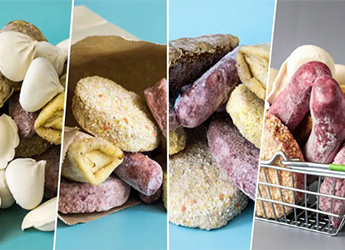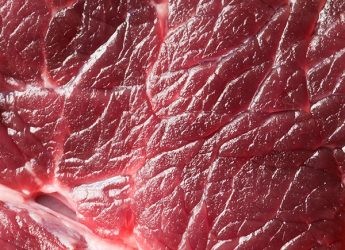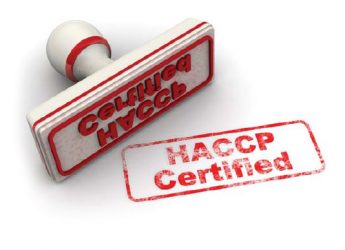Top-quality meat production
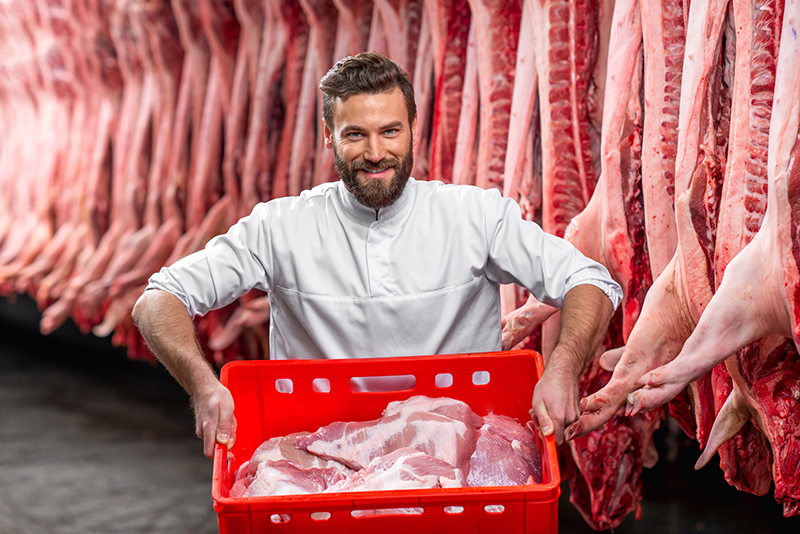
Meat science basics
In the muscle tissue of the meat, a small amount of oxygen is stored, sufficient for a short period, then this reserve is depleted. As a result, it is a metabolic process without oxygen (i.e., under anaerobic conditions) that leads to the formation of lactic acid. Lactic acid, as an end product of anaerobic metabolism, is not excreted and therefore accumulates in muscle tissue. Hence the drop in pH (the final pH depends on the amount of glycogen present in the muscle tissue at the time of termination of the animal’s vital activity, so usually the pH level ranges from 7.4 to 5.6).
The information is based on data for beef, but it also applies to pork and lamb.
- Procedure:
- Breeding.
- Transportation.
- Lairage.
- Stun/slaughter.
- Sticking.
- Rimming-over the legs and sking.
- Sawing up the breast of cattle, gutting, and dividing the carcass into half carcasses.
- Trim and wash of the carcass.
- Cooling and examination of the carcass.
- Deboning and cutting of half carcasses on the conveyor line.
- Shrink vacuum packing of the junctures.
- Cooling system control
- Loading and dispatch of vacuum-packed junctures.
- Production.
- Consumer packaging.
- Boxes` placement and shipment.
- Retail.
Stress exposure before slaughter
DFD – dark, firm, and dry meat when cutting:
- Slaughter of cattle and pigs causes chronic stress before it starts.
- Depleted glycogen stores in muscle tissues leading to low levels of lactic acid production.
- Represented by dark, firm, dry muscles with a high upper pH.
- pH level above 6.0 after 24 hours.
- Microorganisms that produce hydrogen sulfide grow in dark, firm, dry meat.
- Hydrogen sulfide reacts with myoglobin, resulting in a green tint and off-flavors when the meat is vacuum packed.
- Vacuum-packed meat should not be stored for a long period.
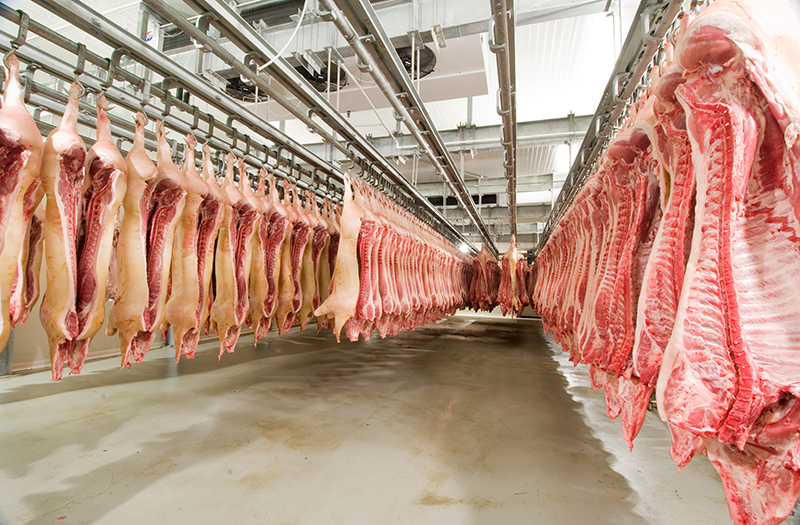
Slaughter Hygiene Measures:
• Meat is practically sterile in healthy animals.
• Slaughter and skinning are the first sources of microbial contamination of fresh meat.
• Two knife actions (color coded) – external/internal cut. It is important at the time of cutting the animal’s larynx.
• Avoid the interval between stunning and slaughter (blood spill).
• Pollution occurs in the removing the skin and offal process, as well as excavating the insides.
• Overlapping of the blue end of the stomach and esophagus.
• Understanding the problem of cross-infection
Effective Hygienic Cooling Mode:
• The refrigerator compartment must be prepared before loading. Relative humidity should be at 95%.
• Moderate chilling so that no part of the carcass is chilled below 10°C at pH level above 6.2.
• Below pH 6.2, lower the temperature to speed up the process, but not as fast as freezing.
• In practice, the temperature of all carcass fragments should not fall below 10°C for 10 hours after slaughter.
Cold Shortening (CS):
• Rapid freezing before rigor mortis sets in causes irreversible contraction of the muscle fiber, resulting in cold contraction and toughness in the meat.
• Beef carcasses are most susceptible to shrinkage due to the relatively slow decrease in pH.
• Shrinkage can be caused by a high velocity of cold air passing over the surface of the carcass, although the fat layer usually softens the effect (10 to 10).
• Not removing the heat fast enough can cause the meat to spoil at the bone in the back of the carcass, as well as a strong odor deep in the muscle tissue.
High voltage electrical stimulation (ES):
• Traditional cooling process causes microbial growth and increased dehumidification.
• High-voltage electrical stimulation can accelerate the post-mortem breakdown of glucose, allowing more rapid glycogen removal.
• Electrical stimulation induces muscle work with the help of electrical impulses passing through the entire carcass within an hour after slaughter.
• Each contraction uses glycogen and adenosine triphosphate.
• This mechanism prevents cold contraction, and the meat becomes softer.
• Rapid cooling must be matched with lowering the pH level, otherwise, excessive dehumidification will occur.
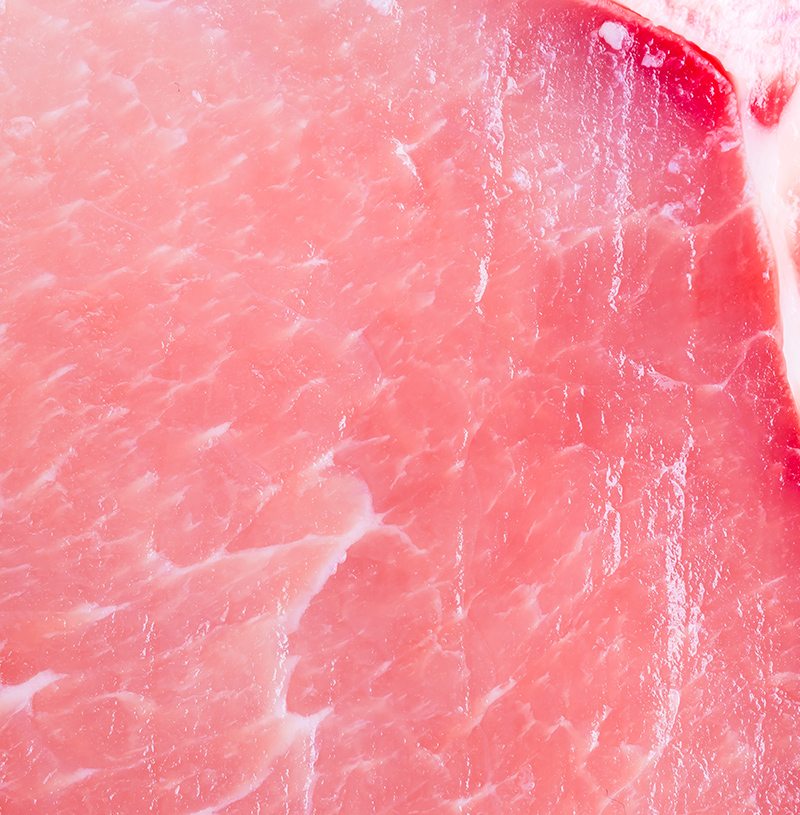
Hanging on the sacrum:
• Must be done before rigor mortis (1 hour after slaughter).
• Eliminates the problem of muscle strain, so they become relaxed and take on the same shape as the animal.
• The result is more tender meat, especially “round steak”.
• No particular advantage for the front of the carcass.
Hygienic deboning:
• pH control to detect carcasses with dark, firm, and dry meat.
• The temperature in the deboning room is not more than 7°C.
• Carcasses and products are moved to ensure the shortest possible refrigeration interval (ideally less than 20 minutes).
• Effective regular sensitization of tools, cutting surfaces, and equipment.
• Deboning at speeds compatible with vacuum packaging equipment.
Vacuum packing and heat shrinking in hot water:
• A good level of vacuum (no more than 5mb) and strong sealed seams are very important to improve the quality during the ripening period.
• High shrink (85°C for 1.5 sec.) without blanching for minimal liquid loss during storage and distribution.

